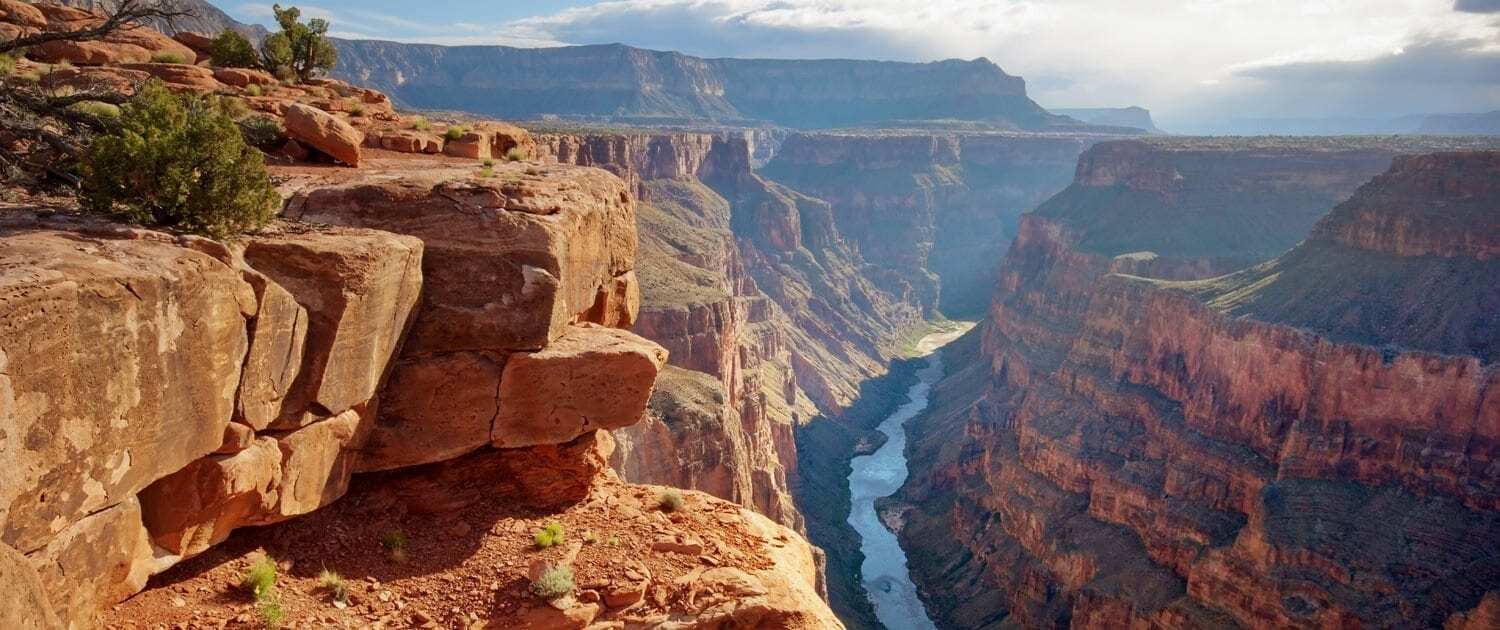Grand Canyon Visitor Center & IMAX — Frequently Asked Questions
Everything you need for the Grand Canyon Visitor Center IMAX Theatre in Tusayan and planning your South Rim visit.
Visitor Center & IMAX Essentials
Where is the Grand Canyon Visitor Center IMAX located?
In Tusayan, just one mile south of the South Rim entrance to Grand Canyon National Park.
What are the Visitor Center hours?
March 1–Oct 31: 8 AM–10 PM. Nov 1–Feb 29: 9 AM–8 PM. Hours may vary on holidays or special events.
What are the IMAX showtimes?
March–October: first show 8:30 AM, last at 8:30 PM. November–February: first show 9:30 AM, last at 7:30 PM.
How large is the IMAX screen?
Six stories tall (about 70 ft high × 82 ft wide) with 12,000-watt, 6-channel surround sound.
What movie is currently showing?
Grand Canyon: Rivers of Time — a 35-minute immersive IMAX® film.
How much are tickets?
Adult, child, and senior pricing available; discounts online; children 5 and under are free. Check the site or box office for current rates.
Can I buy tickets online?
Yes. Mobile tickets are accepted at the theater.
Are group discounts available?
Yes, for groups of 15+ with advance reservations.
What dining options are on-site?
Explorer’s Café (with Pizza Hut Express) and café for quick meals and beverages.
What can I find in the gift shop?
Books, maps, apparel, Native American crafts, and Grand Canyon-themed gifts.
Can I purchase park passes here?
Yes — including the America the Beautiful annual pass and Grand Canyon entrance passes.
Do staff provide trip planning help?
Yes. Staff can help with routes, tours, lodging, and events so you use your time efficiently.
Tours & Activities
What types of tours can I book at the Visitor Center?
Pink Jeep Tours.
What’s special about Pink Jeep Tours?
Premium off-road vehicles and expert guides delivering rim viewpoints and photo stops.
What’s the difference between helicopter and airplane tours?
Helicopters fly lower with more intimate canyon views; airplanes cover more ground at a lower cost per seat.
Are rafting trips available?
Yes, from half-day to multi-day expeditions with licensed outfitters. Book ahead, especially in peak months.
Can I take a train to the canyon?
Yes — the Grand Canyon Railway runs from Williams, AZ and offers a vintage “Wild West” experience.
Are self-guided driving tours available?
Yes — GPS-enabled audio apps guide you to top overlooks with narration and tips.
Can schools or large groups book tours?
Yes — educational and group programs with special pricing are available; reserve in advance.
Horseback & Mule Adventures
Are horseback rides available near Tusayan?
Yes — Grand Canyon Trail Rides operates scenic tours in the Kaibab National Forest near Tusayan.
What ride durations are offered?
Common options include ½-hour, 1-hour, 1½-hour, and 2-hour rides.
EV Charging & Practical Access
Are there EV charging stations at the Visitor Center?
Yes — six Electrify America DC fast chargers (150–350 kW) on site in Tusayan.
How long does charging take?
Most EVs reach ~80% in about 30 minutes on a DC fast charger (speed varies by vehicle and state of charge).
What does charging cost?
Rates vary (per-kWh or per-minute by state). Nearby Level-2 options typically bill by the minute (often about $0.03/min).
Do I need a membership or app?
Credit cards work fine; an app/membership can reduce cost (often ~25% savings on some networks).
Are chargers available inside the park?
Yes — free Level-2 chargers are commonly found at Market Plaza, Yavapai Lodge East, and Maswik Lodge (including Tesla plugs).
Is there a Tesla Supercharger nearby?
Yes — Tusayan has a Supercharger site (multiple stalls) convenient to the Visitor Center.
Hiking, Overlooks & Itineraries
What are the most popular trails at the South Rim?
Rim Trail (easy scenic), Bright Angel (gradual descent), South Kaibab (steeper panoramic), and Hermit (rugged, quieter).
Can I hike to the river and back in one day?
Strongly discouraged. Heat, distance, and elevation gain make it hazardous for most hikers.
What can I see with only a half-day visit?
Watch the IMAX for orientation, then visit Mather Point & Yavapai Point or stroll a Rim Trail segment.
What should I do with a full day?
IMAX + Hermit Road shuttle for overlooks, Yavapai Geology Museum, and a short hike below the rim.
What about a two-day trip?
Day 1: IMAX, Rim Trail, overlooks. Day 2: half-day below-rim hike or an air/rafting tour.
Where are the best sunrise views?
Mather Point and Yaki Point are favorites for first light.
Where are the best sunset views?
Hopi Point (via the Hermit Road shuttle) offers sweeping west-facing vistas.
What historic sites can I visit at the South Rim?
Kolb Studio, Hopi House, El Tovar Hotel, and additional village landmarks.
Where are ancient ruins located?
The Tusayan Ruins are about three miles west of Desert View (east rim area).
Is there a family-friendly trail?
Yes — the paved Rim Trail is stroller-friendly with frequent viewpoints and shuttle access.
What should hikers bring?
Water (more than you think), salty snacks, hat, sunscreen, sturdy footwear, and layers for temperature swings.
How can I avoid crowds?
Arrive early or stay late, use shuttle routes, and consider below-rim trails where foot traffic thins quickly.
Seasonal & Wildlife Tips
How does weather vary by season?
Summers are hot and dry; winters can bring snow/ice; evenings are cooler year-round. Always check the forecast.
Are shuttles seasonal?
Hermit Road is shuttle-only for much of spring–fall; schedules adjust by season.
Are campfires and wagon rides seasonal?
Yes — fire bans and weather can pause these activities. Check conditions before you go.
Are mule rides offered year-round?
Generally yes, but capacity is limited and may be reduced in winter. Book well ahead.
What’s the best time of year to visit?
Spring and fall offer milder temps and lighter crowds; summer has full services but peak visitation.
Do park facilities close in winter?
Some lodging, tours, or services reduce hours or close seasonally. Confirm specifics before arrival.
What wildlife might I see?
Elk, mule deer, bighorn sheep, ravens, and (with luck) California condors riding thermals.
How do I keep wildlife safe?
Stay at least 100 ft/30 m from wildlife, never feed animals, and secure food/waste.
Are ranger programs offered year-round?
Yes — topics and locations vary by season; check the daily schedule on arrival.
Practical Visitor Info
Do I need a park pass to visit the IMAX?
No — the Visitor Center IMAX is in Tusayan, outside the park gates.
Is parking available?
Yes — free parking for cars, buses, and RVs at the Visitor Center.
Is the Visitor Center ADA-accessible?
Yes — the theater and common areas are wheelchair accessible.
Are restrooms available?
Yes — accessible restrooms are located inside the facility.
Can I bring food or drinks into the theater?
Only concessions purchased on-site are allowed in the IMAX auditorium.
Are pets allowed?
Pets are not allowed inside the theater or food service areas (service animals permitted).
Do you accept credit cards?
Yes — major credit/debit cards are accepted at box office, café, and shop.
Is there free Wi-Fi at the Visitor Center?
Yes — complimentary Wi-Fi is available for guests.
How far is the Visitor Center from Grand Canyon Village?
Roughly 7 miles (10–15 minutes by car), just inside the park after the South Entrance Station.
Why should I start my trip at the Tusayan Visitor Center?
Save time with maps and expert advice, secure tickets/tours/food, and get oriented with the IMAX film before entering the park.
Frequently Asked Questions About the Grand Canyon
General knowledge for visitors—geology, distances, weather, safety, access, and more.
Geology & Formation
How old is the Grand Canyon?
Most experts estimate the canyon itself is about 5–6 million years old—when the Colorado River arrived and began carving it. Some theories suggest parts of the western canyon may be older (by ~10 million years). The rocks you see in the walls are far older (hundreds of millions to billions of years).
Age of incision vs. age of rock: the canyon is “young”; the rocks are ancient.
How deep is the Grand Canyon?
From the South Rim, ~6,000 feet at its deepest; from the higher North Rim, closer to ~8,000 feet at the deepest points.
How wide is the Grand Canyon?
Roughly 10–18 miles across in many sections.
How was the Grand Canyon formed?
Over vast time, a combination of processes shaped the canyon:
- Deposition: Changing environments laid down sediments that became rock layers (a “time record”).
- Uplift: The Colorado Plateau (≈140,000 sq mi) rose, lifting all those layers.
- River incision: The Colorado River cut down through the uplifted rock, exposing strata.
- Lake overspill (hypothesis): Ancient Lake Bitahochi may have overspilled, adding erosive force.
- Lava dams: Basalt flows created multiple temporary dams, affecting river flow and canyon width.
Some mechanisms remain debated; the broad outline above reflects widely cited factors.
How long is the Colorado River?
About 1,450 miles from Colorado to the Sea of Cortez—277 miles of which flow through Grand Canyon.
Safety, Weather & Nature
Can I drive to the bottom?
No public road descends from the South or North Rim to the river within the national park. Limited river access exists outside the park via tribal/forest roads, but not for typical sightseeing.
Why are temperatures so different from rim to river?
Elevation change, plain and simple. The river corridor is much lower and significantly warmer.
What are all the colorful layers?
They’re strata—distinct rock layers formed in different environments across ~2 billion years, each with its own color and composition.
Does it snow here?
Yes—especially on the South Rim (≈7,000 ft). It’s typically too warm for snow to persist at river level.
What is the average rainfall?
About 10–13 inches annually on the rims; less than 10 inches near the bottom.
Is hunting allowed in the National Park?
No. Hunting is prohibited inside Grand Canyon National Park.
Do people die here?
Sadly, yes—on the order of 5–15 a year on average, often hikers. There are 300+ rescues annually.
Know your limits, carry water, and plan conservatively.
Park Facts & Distances
How big is the National Park?
About 1.2 million acres (≈85% is canyon terrain).
When did it become a National Park?
1919.
How many different species of life are found in the Grand Canyon?
On the order of ~2,000 species (plants, animals, and more).
How many species of animals?
Roughly ~500 animal species.
Are there rattlesnakes on the rim?
Rarely seen on the rim, but they do live in the region. Always watch where you step.
How long does it take to drive from South Rim to North Rim?
About 4½ hours by road (it’s a long way around).
How are rapids on the Colorado River rated?
Grand Canyon uses a 1–10 scale (distinct from the international I–VI). Several rapids can reach a “10” at certain flows.
How far is Phoenix?
≈231 miles (by road, from the South Rim area).
How far is Flagstaff?
≈81 miles.
How far is Las Vegas?
≈278 miles.
How far is the North Rim?
≈212 miles from the South Rim by road.
Culture & History
How many Native American tribes are here?
Five tribes have Grand Canyon lands: Paiute, Havasupai, Hualapai, Navajo, and Hopi.
How long have Native Americans been here?
Evidence of human presence dates back ~12,000 years, including hunters following now-extinct megafauna (mastodons, mammoths, giant ground sloths, saber-toothed cats).
Does anybody live down in the canyon?
Yes. Staff reside at Phantom Ranch (overnight stays by reservation), and the Havasupai live in Supai Village (about two-thirds of the way down in their canyon).
What is the Painted Desert?
Colorful badlands to the northeast—homeland to the Navajo and the Hopi.
Where are the Indian reservations?
The Hopi and Navajo reservations are roughly ~80 miles from the park.
Will we see Native Americans?
Possibly. Hopi, Navajo, and Apache peoples are active in the broader region and maintain cultural traditions.
Where is the glass skywalk?
On Hualapai land at Grand Canyon West, roughly 4 hours from the South Rim (toward Las Vegas).
Hiking & Activities
How long does it take to hike to the river?
Commonly 4–6 hours down—and double that to hike back up. Not recommended as a day hike for most visitors.
What are the tall trees on the rim?
Primarily Ponderosa pines at South Rim elevations.
What is the best way to see the canyon?
It depends on time and budget. Start at the Visitor Center for advice and maps, then consider tour buses, helicopter or airplane flights, and mule rides. Mixing rim viewpoints with a short below-rim hike is ideal.
What is the best view of the canyon?
There’s no single “best” viewpoint. West Rim Drive (Hermit Road) and East Rim Drive (Desert View Drive) both offer outstanding vistas.
Weather & Accessibility
What is summer like—and does it snow there?
The South Rim (~7,000 ft) is warm in summer and cold/snowy in winter. Below the rim, temperatures are often ~20°F higher than on top.
Is the park wheelchair accessible?
Many facilities are historic and some don’t meet modern standards. For detailed guidance, request the Accessibility Guide (PO Box 129, Grand Canyon, AZ 86023) or consult the NPS accessibility resources.
Transportation, Food, Lodging & Camping
What time does the park close?
The South Rim is open 24/7, 365 days a year. Camping, lodging, and restaurants operate year-round; reservations are strongly recommended in summer. Some facilities reduce hours or close in winter.
Is there a shuttle bus in the park?
Yes. Grand Canyon National Park operates a free shuttle system. The Village Route runs year-round; seasonal routes serve other areas.
Are there restrooms throughout the park?
Yes—restrooms are located at visitor centers, major viewpoints, and key facilities.
Is food available in the park?
Yes—restaurants and groceries are available inside the park and in Tusayan (~7 miles south of the village area). A food court is also available at the Grand Canyon Visitor Center complex.
Is camping available in the park or in the canyon?
Yes. Mather Campground (tents) and Trailer Village (RV hookups) take reservations (historically via 303-297-2757 / recreation services). Additional camping is available outside the park at Camper Village or dispersed sites in Kaibab National Forest (Tusayan Ranger District, PO Box 3088, Grand Canyon, AZ 86023).
Where is lodging available?
Inside the park (Grand Canyon Village lodges), in Tusayan (just outside the South Entrance), and in Williams (~50 miles south).


